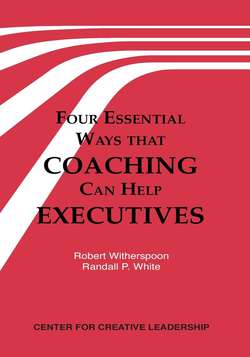Читать книгу Four Essential Ways that Coaching Can Help Executives - Robert Witherspoon - Страница 9
На сайте Литреса книга снята с продажи.
ОглавлениеIntroduction
Imagine a professional football team that recruits the best players, puts them through training camp to hone their technical skills and learn the plays and strategies to win, and then plays the entire season without a practice session or a coach. There’s not a team owner in the world who would ever expose such a major investment to that kind of risk. Yet most traditional practices in organizations seem to do just that. People are expected to perform key roles—to lead a new project team, to present financial results to outside investors, to manage conflicts across departments—all in an exemplary fashion, without training, practice, or coaching. Consequently, many investments in people—the human side of enterprise—have had mixed results. So many organizations have turned to coaching. Coaching is recognized in business, in teaching, and in sports as a positive and empowering strategy for performance and leadership development.
Effective executive coaching brings out the best in people. The very first use of the word “coach” in English occurred in the 1500s to refer to a particular kind of carriage. (It still does.) Hence, the root meaning of the verb “to coach” is to convey a valued person from where he or she was to where he or she wants to be. That’s still a good meaning for coaching executives today (see Evered & Selman, 1989).
For decades, athletes, public speakers, and performing artists have turned to coaches to help them perform better. For individuals already atop their fields, the next level of performance can’t be taught, but it can be learned. To coach in these situations is less to instruct than to facilitate (literally, “to make easy”). Now this approach has taken hold in business, where top executives are turning to coaches to reach their business and personal best.
Coaching entails individually helping executives to learn and to make the most of that learning. Because these encounters involve executives in different stages of their careers and in varied settings, coaching represents a continuum of roles. Sans role, coaching is a process that helps executives learn, grow, and change. What the coaching involves specifically—whether by Socratic method or multi-rater assessment—depends on the executive and the situation. Coaching is situational, a point captured over a decade ago by Peters and Austin (1985):
In our work with exceptionally talented leaders and coaches, we’ve discovered that they make dozens of intuitive judgments daily about how to work with their people. Sometimes they focus on removing barriers to performance. Other times they immerse themselves in a situation and exert a great deal of influence on the way it turns out. There are times when they help people work through personal or performance problems, and there are times when the only requirement is to provide straightforward information. In some situations the coach is the dominant figure, while in others the team practically forgets he or she is there. (pp. 398-399)
Experience bears this out with two important exceptions. The first concerns the person coaching. Peters and Austin were talking about leaders and coaches as the same person, typically one’s boss or another insider. Since then, a growing number of executives have turned to professional external coaches. According to a recent survey of coaching practices at leading American companies, those coached in business these days “may be anyone from a $60,000 middle manager up to the CEO, although more commonly that person will be a leading contender for the CEO’s job” (Smith, 1993). As described in this Fortune article, executive coaching involves a skilled outside consultant assigned to an executive on a regular basis for one or more specific functions—to improve the executive’s managerial skills; to correct serious performance problems; and/or to facilitate long-term development, often for a future leadership role or top corporate position.
The second exception concerns the exertion of influence. Typically, outside coaches have little or no direct influence—much less control—over the outcome. To have direct control is to manage, not to coach. It is the coach’s lack of direct control or authority that makes the coaching task difficult and challenging. A coach, however, can have considerable power depending on reputation, track record, access to other parts of the organization, and so forth. Absence of authority also makes possible major change, because the person being coached must be motivated internally. True, a coach can be instrumental in encouraging or motivating the executive to learn and to change, but ultimately the changes must be embraced by the executive if they are to be effective.
This paper focuses on the specific functions referred to above, called coaching roles. Coaching is more than an event (for example, the feedback day of a leadership development program); it’s a continuous process. Good coaching requires a skill, a depth of understanding, and plenty of practice if it is to deliver its remarkable potential. Although some coaches reside inside the organization, this paper addresses the role of external one-on-one coaches in a business context. It does not address other settings, like personal growth seminars or “cyber coaching” over the Internet. Nor does it address group coaching functions like boardroom facilitation and team development. The focus here is on formal coaching—when regular sessions are scheduled and conversations occur—rather than on the many informal opportunities for coaching that arise on a daily basis.1
